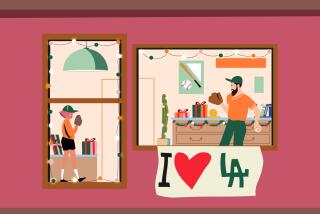St. Croix Mahogany Is Hand-Carved With Care
- Share via
FREDERIKSTED, St. Croix — “It can take four to six years for a block of mahogany to be sufficiently dry or well-enough seasoned for us to work with it,” says William Thomas, manager of St. Croix Life and Environmental Project (LEAP), a workshop for skilled and ecologically concerned woodworkers.
“That gives us a lot of time to get to know its character and think about what we’re going to use it for.”
LEAP sits on a bluff overlooking the ruins of an abandoned sugar plantation, inland from the town of Frederiksted on the western coast of St. Croix. Hand-carved mahogany signs lead the way to the rustic workshop area, part barn and part in the open air.
Integrity--of the wood and the work--is something that’s valued at LEAP. Although the workshop is in the middle of a rain forest, the LEAP organization of five master woodworkers and six apprentices only uses trees that have been felled naturally in storms or have been cut down for land development projects.
LEAP members see their work as a rescue mission of sorts because much of their material is retrieved from destruction. In addition, they dedicate part of their profits to island reforestation.
Reforestation is definitely needed. St. Croix was once carpeted with mahogany trees, but 250 years of plundering by Spanish, English, French, then Danish colonials took its toll. The wood is now relatively rare.
Caribbean mahogany is a particularly hard wood that is resistant to insects and fungi and adapts well to changes in temperature and humidity without warping.
That makes it ideal for a wide variety of uses, from shipbuilding to furniture making. Caribbean mahogany was the wood of choice for British and American furniture makers during the 19th and early 20th centuries. Mahogany native to the Caribbean and Central America is different from that grown in Africa.
LEAP has been salvaging wood for about 17 years, about as long as the organization has been in existence.
It was founded by Fletcher Evans Pence, a master carpenter and environmental visionary whose deep appreciation of nature developed during his youth in Northern California. Pence died three years ago, but the LEAP project continues very much according to his original vision, under the current leadership of Thomas, one of Pence’s proteges.
The work is arduous. LEAP artisans haul logs from all over the island to the workshop. They saw and stack the wood, and work it when it is dry. The moist mahogany is much lighter in color--sometimes almost salmon pink in hue--than the dried and seasoned wood.
Some of LEAP’s standard pieces are made collectively. Among them: bread boards (from $15 and up), small boxes (from $25 to $1,500), mobiles featuring a variety of fish or a cluster of dolphins (from $45 to $75), bookends (about $15 to $20 each), puzzles (from about $15), canes and walking sticks (from $18) or slab-like table tops (from about $200). But the most interesting pieces are often the products of individual design and workmanship.
These are often free-form chairs, tables and fantasy animals, the shapes of which have been determined by the form and grain of the wood.
Prices for finished pieces are determined not only by the amount of labor they required, but also by the inherent quality of the wood.
Thomas frequently makes hand-turned mahogany canisters or humidors with tight-fitting lids. They’re from $75 to $1,500, depending on the size of the jar and the quality of the wood.
Free-form chairs (from $250 to $2,500) and free-form coffee tables and dining-room tables (from $3,000 to $15,000) are the pieces for which LEAP is best known, and of which they are the proudest. The most extraordinary and valuable chairs are made from a single piece of wood. Special orders are taken for larger, complicated pieces.
And nothing at LEAP is wasted. Tiny pieces of mahogany are shaped into palm-size worry stones, smooth-surfaced ovals intended to be rubbed during attacks of nerves or anxiety. They cost $3 each, and are the least expensive items made at LEAP.
LEAP products are sold only at the workshop. To get there, take a private car or taxi from Frederiksted on Route 70 north to Route 76 (Mahogany Road) east. Follow the hand-carved signs to the LEAP workshop.
To get there from Christiansted, take Route 75 (North Road) to Route 70 (Centerline Road), then make a right turn to Route 76 and follow the hand-carved signs.
The workshop is about 15 miles from Christiansted. If you rent a car, be prepared to drive on the left side of the road.
The workshop is open from daybreak to about 4 p.m. daily, but it’s best to telephone (809-772-0421) before making the trip. Thomas lives on the premises.
Orders can be shipped, and there are no import duties charged on items produced in the U.S. Virgin Islands.
More to Read
Sign up for The Wild
We’ll help you find the best places to hike, bike and run, as well as the perfect silent spots for meditation and yoga.
You may occasionally receive promotional content from the Los Angeles Times.






